Alexander Cumming (ca. 1731 – 1814)
John Hill (1714 – 1775)
by Brian Stevenson
last updated February, 2022
The names of Alexander Cumming and John Hill are intertwined in microscope history due to Hill’s production of a book on structures of wood as examined under the microscope, which was made possible by a microtome invented by Cumming (Figures 1-3). George Adams wrote that prior to the publication of Hill’s book in 1770, interest in microscope development had waned, “either satisfied with the discoveries already made … or tired by it's own exertions”. Hill’s The Construction of Timber from its Early Growth, Explained by the Microscope described the fine structures of woods, and provided ways to evaluate strength, etc. of this important construction material. Adams wrote, “So important a subject soon revived the ardor for microscopic pursuits, which seems to have been increasing ever since”. The Cumming-pattern section cutter was subsequently improved upon by Robert Custance, whose highly-regarded plant sections further stimulated excitement over the microscope.
Most of us will never be able to afford one of Cumming’s section-cutters, nor any of the
fine clocks and other instruments he constructed. Fortunately, at least two Cumming microtomes appear to be on public display, at England’s Museum of Science History and The Science Museum (Figure 3). Hill’s ground-breaking book can be freely downloaded via the internet.
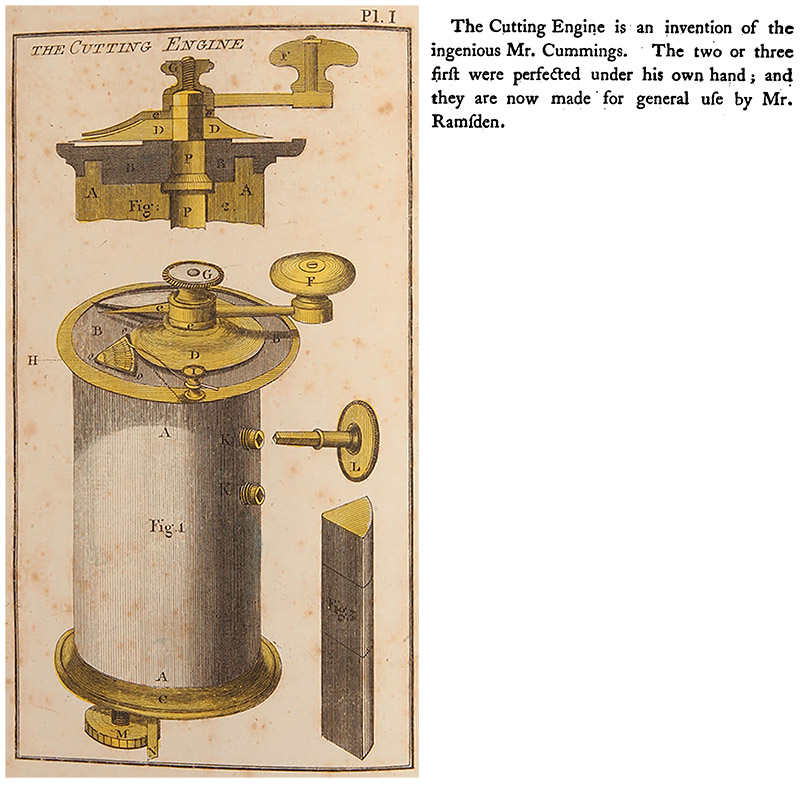
Figure 1.
Engravings of the Cumming cutting-engine, from Hill’s ‘The Construction of Timber from its Early Growth, Explained by the Microscope’. In functioning, a piece of wood was adjusted through the body to
protrude through the wedge-shaped opening visible to the upper right. The elliptical blade is then rotated against the wood, using the sharp edge and friction to slice off a thin section. The circular mechanism belies Cumming’s chief occupation as a clockmaker. The Museum of the History of Science notes that, “The rotary blade is difficult to make, and very difficult to keep sharp”.
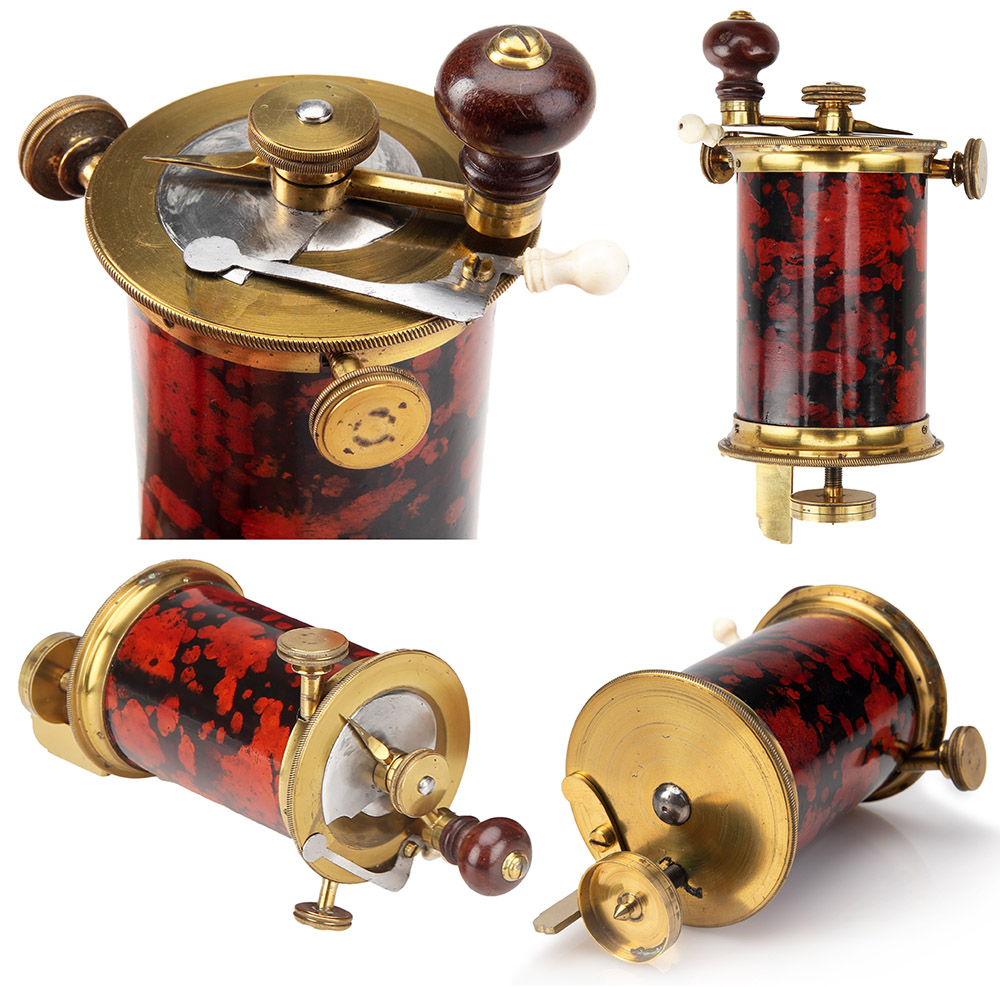
Figure 2.
A Cumming-pattern microtome. Images adapted for nonprofit, educational purposes from an internet auction site.
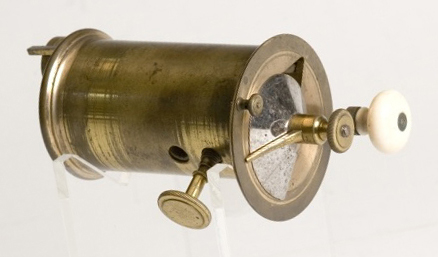
Figure 3.
A Cumming-pattern microtome, at the Museum of Science History, Oxford, England. This instrument is marked as having been made by Jesse Ramsden, who is reported to have made the majority of Cumming-pattern section cutters. Ramsden was master to William Cary, who later became famous for the microscopes invented by his employee and former apprentice, Charles Gould. They Museum states, “This particular machine has been used in 1974 to test its performance, and it produces good sections of about 20 micrometres in thickness”. Used for
nonprofit, education purposes, adapted from http://www.mhs.ox.ac.uk/collections/imu-search-page/record-details/?TitInventoryNo=65389&querytype=field&thumbnails=&irn=1733.
Another Cumming-pattern microtome, with an ivory body, can be seen on line at
the Science Museum, http://www.ssplprints.com/image/81932/microtome-1770
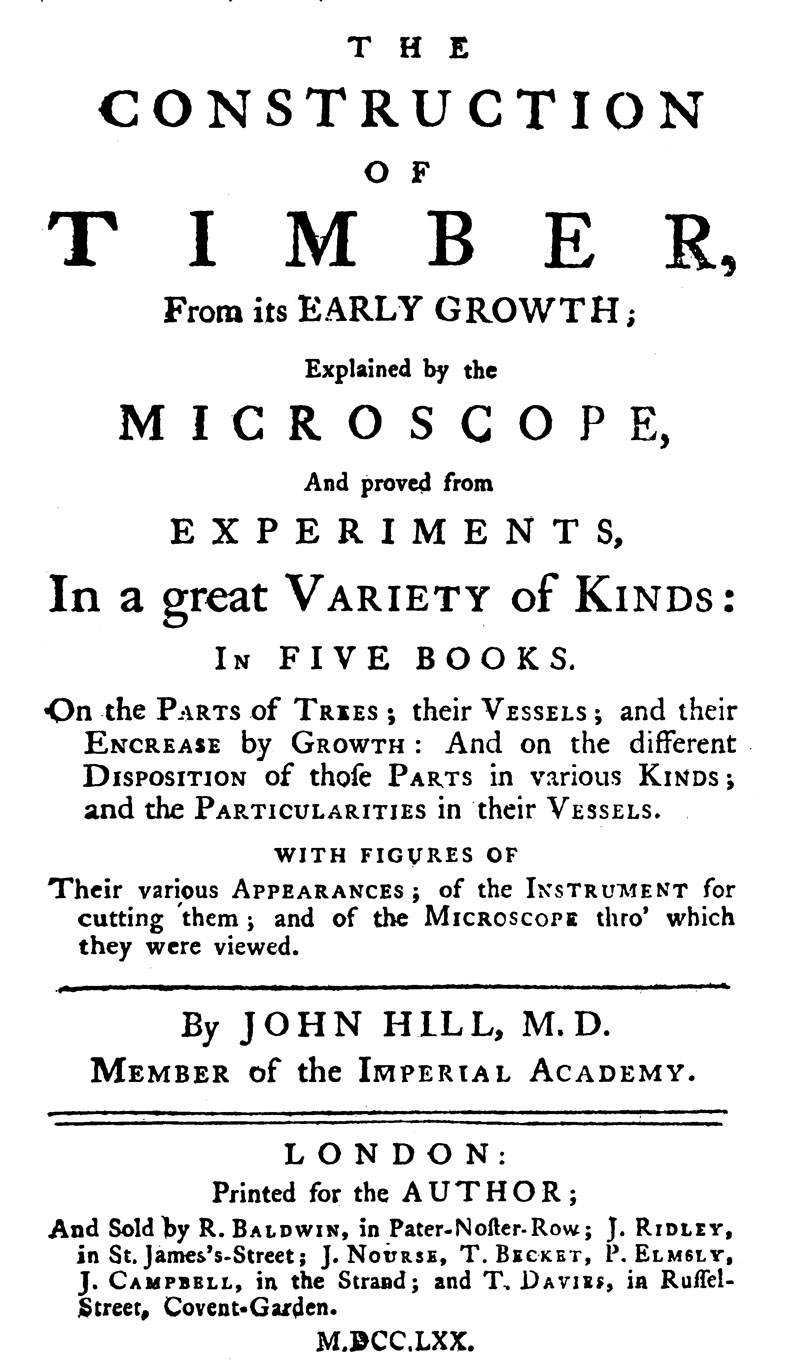
Figure 4.
Cover of John Hill’s 1770 book on wood morphology.
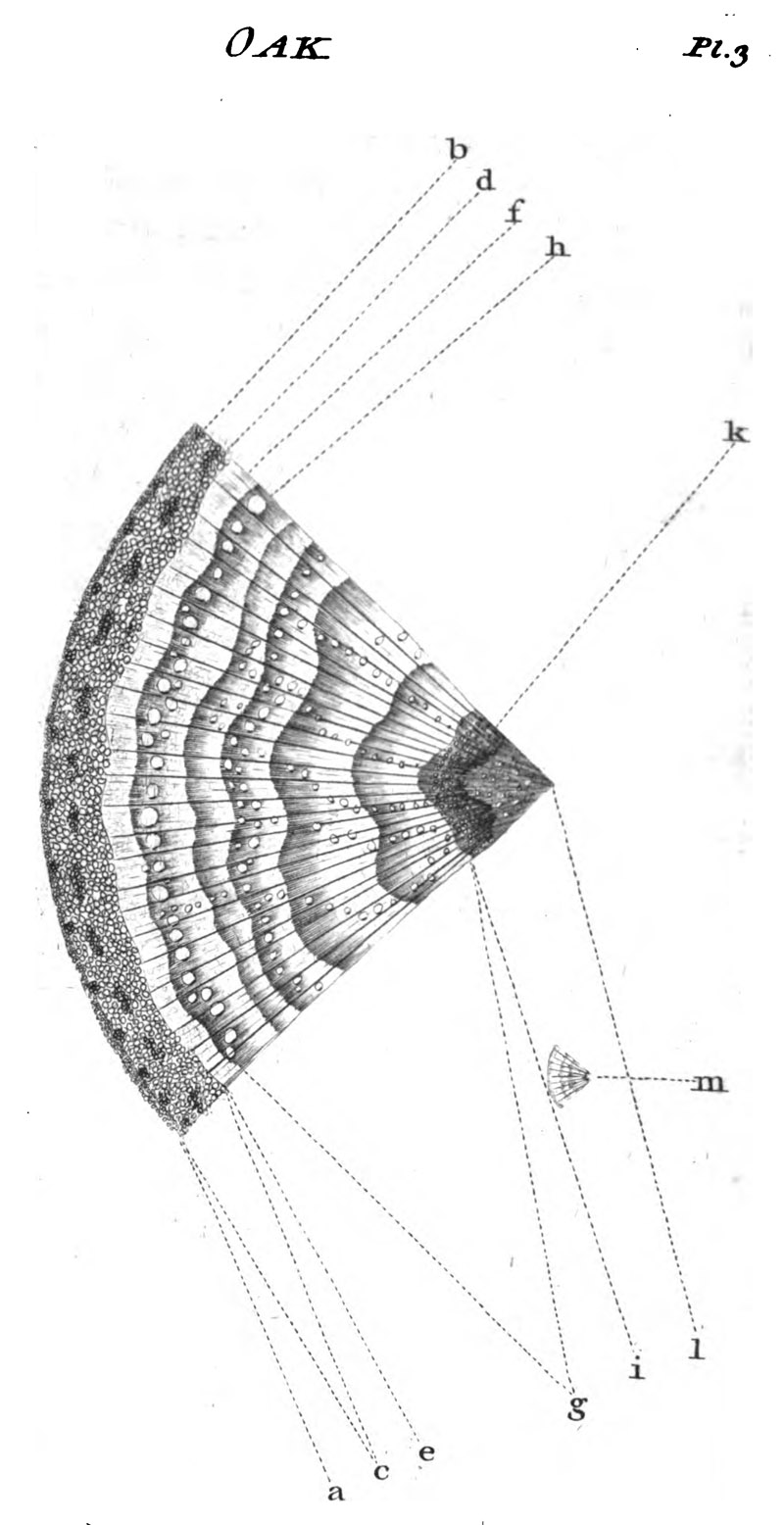
Figure 5.
A plate from Hill’s ‘Construction of Timber’, showing fine details of oak wood. This was made possible by Cumming’s section-cutter.

Figure 6.
(left) John Hill and (right) Alexander Cumming.
John Hill
was born in Peterborough, Cambridgeshire, in 1714, son of clergyman. He
apprenticed as an apothecary, and was awarded an MD in 1750. He lived in London
from, at latest, 1738. Along with those occupations, he edited The British Magazine until 1750, and
after that, wrote a daily column for The
London Daily Advertiser. He wrote over 100 books and pamphlets, including
novels, plays, medical texts and scientific works. Some of his works were taken
seriously, but much was considered hack work. Hill created a stir from his
frustrated attempts to join the Royal Society. Although the Royal Society was England’s
premier scientific organization, in the mid-1700s many of its members were
non-scientists, while actual, working scientists such as Hill were often
excluded. Eventually, Hill became so disappointed by his rejection that he
published works that derided the Society.
Botany was one of Hill’s main interests, likely due to the extensive use of plants in medicines. His 1757 British
Herbal caught the attention of the Earl of Bute, who engaged Hill to work
with his botanical collection and revise Linnaeus’ nomenclatures. The resulting
Vegetable System ran to 26 volumes.
Bute was
also a patron of Alexander Cumming, and likely helped bring the machinist and
the botanist together. That level of society probably also brought them into
contact with George Adams Sr., Optician to the King. Adams’ microscopes and
Cumming’s microtomes enabled Hill’s detailed examination of woods that led to his significant Construction of Timber from its Early Growth, Explained by the Microscope. After the Earl of Bute died in 1792, the sale of his effects included several Cumming microtomes.
Alexander
Cumming was born ca. 1731 in Inverness-shire, Scotland. By 1752, he operated a
watchmaking business in Inveraray, Argyll, and was a significant enough citizen
to be enrolled as a burgess. He was patronized by the Duke of Argyll, and
produced a clock and an organ for the Duke’s castle at Inveraray. Following the
Duke’s death in 1761, Cumming moved to London, establishing a shop on New Bond
Street. He developed a strong reputation as watchmaker. He also developed an
interest in air pressure, and built a clockwork barometric recorder for King
George III (Figure 7).
Cumming
also developed and patented a device that most of us use daily: the curved
drain pipe found in sink drains and toilets (Figure 9). The small amount of
water retained in the “S” curve prevents fumes from coming back up from the
sewer.
Cumming retired
in the early 1790s, moving to suburban Pentonville. He continued to investigate
and write on various mechanical subjects, such as the effects of variously-shaped
carriage wheels on roadways and the use of gravity for mechanical power. He
invested in land in the area, and became a magistrate. He died on March 8,
1814, at the age of 82.
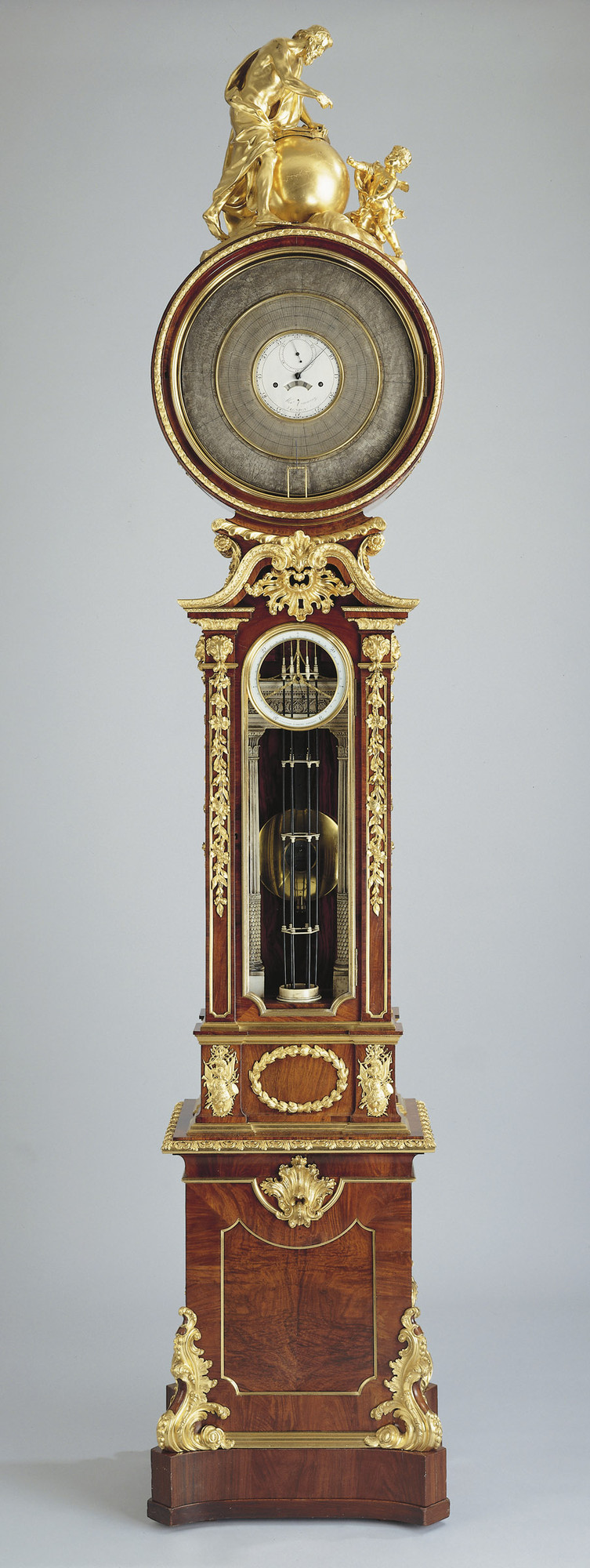
Figure 7.
The clockwork recording barometer made by Alexander Cumming for King George III in 1765. He was paid £150 per year to maintain it.
From http://www.royalcollection.org.uk/collection/2752/barometrical-clock

Figure 8.
A clock by Alexander Cumming. Adapted for nonprofit, educational purposes from an internet auction site.
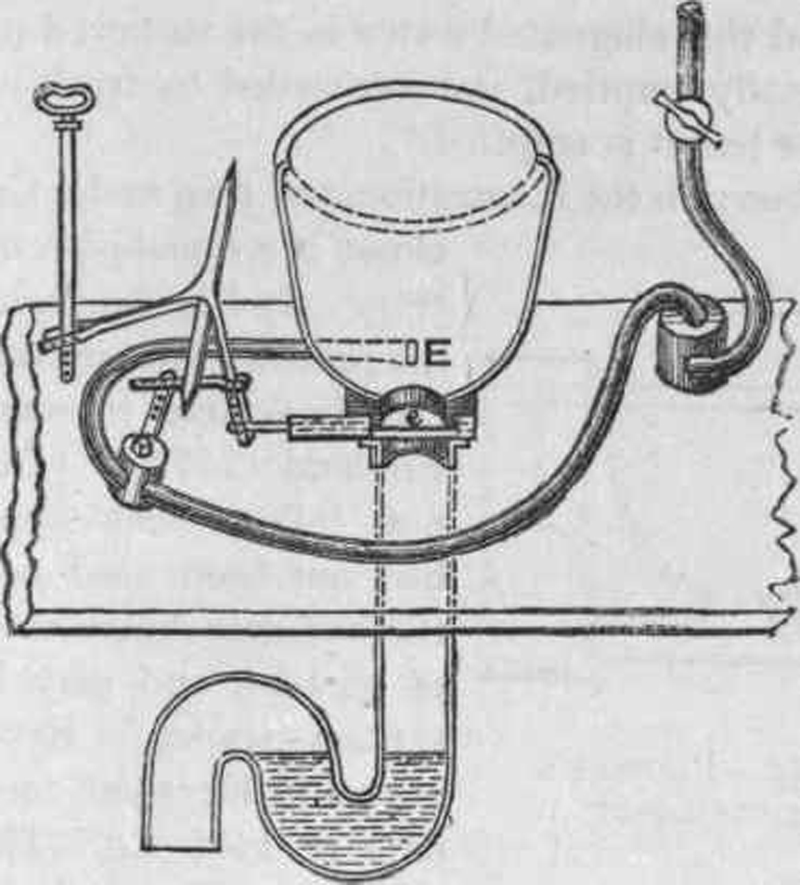
Figure 9.
A diagram of Alexander Cumming’s flush toilet design, which included a curved drainpipe.
Resources
Adams, George (1787) Essays
on the Microscope, first edition, Adams, London, page 21
Adams, George (1798) Essays
on the Microscope, second edition, edited by Frederick Kanmacher, W. &
S. Jones, London, pages 19-20
Clifton, Gloria (2004, online edition 2008) Cumming, Alexander (1731/2–1814),
Oxford Dictionary of National Biography,
Oxford University Press, accessed April 2014,
http://www.oxforddnb.com/view/article/6893
Fraser, Kevin J. (1994) John Hill and the Royal Society in
the Eighteenth Century, Notes and Records
of the Royal Society of London, Vol. 48, pages 43-67
Hellyer, S. Stevens (1891) Priciples and Practice of Plumbing, George Bell and Sons, London, pages 194-196
Hill, John (1770) The
Construction of Timber, from its Early Growth, Explained by the Microscope,
Hill, London
Museum of the History of Science (accessed April, 2014) http://www.mhs.ox.ac.uk/collections/imu-search-page/record-details/?TitInventoryNo=65389&querytype=field&thumbnails=&irn=1733
The Science Museum / Science & Society Picture Library
(accessed April, 2014) http://www.ssplprints.com/image/81932/microtome-1770
Smith, Gilbert M. (1915) The development of botanical
microtechnique, Transactions of the
American Microscopical Society, Vol. 34, pages 71-129








